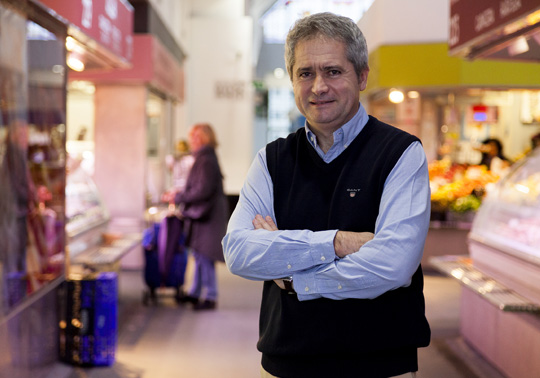Commerce is a basic sector in the economic activity of cities and its state and evolution have repercussions not only on economic aspects, but also on others linked to social aspects and urban development. A piece of research conducted in the UPV/EHU’s Department of Financial Economics II has established the indicators that need to be taken into account to determine the state of commerce in an urban space. These indicators offer the keys on which pressure has to be applied by urban management to ensure a good level of activity as well as to be able to achieve a balance between traditional outlets and the chains and franchises.
The evolution in commerce in the centre of Bilbao has added competitive value to the city
The UPV/EHU has produced a commercial analysis model which has received an award at the Congress of the European Academy of Management and Business Economics
- Research
First publication date: 29/11/2017

As a basic sector in the economic activity of cities, commerce constitutes a key element in the configuration of distinct, competitive, urban spaces. “It has many implications not only from the economic perspective but also from the social and urban planning point of view. What is more, traditional commerce has to face new challenges, such as online trading and the expansion of commercial franchises and chains, etc.”, explained Xabier Olabarrieta-Arnaiz, lecturer in the UPV/EHU’s Department of Financial Economics II.
Concerned about the commercial situation and in order to come up with a practical tool for managing these spaces, Olabarrieta has, in collaboration with Pilar Zorrilla-Calvo, a lecturer in the same department, analysed various factors that determine the capacity for commercial attraction. This analysis has resulted in a methodology to be able to determine the state in which commerce in the urban environment finds itself at a specific point in time.
The methodology developed takes a total of seven features into consideration: the level of commercial activity, in other words, the number of active outlets; the mix or variety of commercial categories (the presence of outlets devoted to catering, the goods and services trade); the types of commercial organisation (independent outlets, franchises, chains, etc.); the geographical origin of the outlets; the trading surface area of the outlets; how long they have been in existence, and the level of development of ICT tools (incorporation of websites, online sales, the presence of social networks, etc.). “All these factors have been determined by previous studies which regard them as being of importance for consumers,” pointed out Olabarrieta. It is worth pointing out also that they have developed innovative indicators for two of the features taken into consideration: variety and commercial typology.
This analysis allows one to find out the state of commerce in an urban environment, but not necessarily the current one. “By applying the methodology to various temporary milestones it is possible to produce an evolving analysis of the urban space under consideration,” he added.
The award-winning analysis of the old quarter of Bilbao
The study conducted was not restricted to developing the tool itself but was applied to Bilbao city centre, specifically to the city’s three central districts: Abando, Indautxu and the Old Quarter, “the commercially stronger districts. We explored how the city centre has changed between 1982 and 2014. To get an overview of the evolution, apart from those two years, we also bore in mind the state of commerce in 1990,” explained the researcher.
The conclusion they reached was that the commerce “has evolved in a positive way in general terms; it is possible to say that the evolution of commerce in Bilbao has added competitive value to the city”. Among other things, they saw that the number of active outlets had increased by nearly 8% and that in terms of commercial origin, the ones not of local origin had increased from 7% in 1990 to 27% in 2014. “Despite being a significant increase, it remains within contained levels,” he felt. The same thing happens with the type of commercial organisation: “The growth of franchises and chains that has taken place is regarded as a positive increase because the number of independent outlets remains significant”.
The authors submitted a paper at the 31st Congress of the European Academy of Management and Business Economics (AEDEM), held in Madrid in June. The paper focussed on the Old Quarter of Bilbao, and as a result of it they were awarded the Prize given by the Metropol-Parasol Chair of the University of Seville for the Best Piece of Research into the Business Management of Urban Tourism and Commercial Spaces.
The prize, according to Olabarrieta, “is designed to encourage the study of tourist areas, from the commercial as well as management perspective; in other words, it recognises the validity of the tool beyond its value in academia”. In this respect, it coincides fully with the initial approach of the study. The tool developed can be used as a monitoring model for commerce to see how it is evolving, and whether any imbalance can be spotted, so that public management can try and apply measures such as mechanisms to support local commerce, to maintain the traditional outlets, or introduce online commerce, etc.
Additional information
This study is part of the PhD thesis by Xabier Olabarrieta-Arnaiz (Bilbao, 1967), entitled El Comercio Urbano como Factor de Competitividad de las Ciudades. Modelo de Análisis de su Estructura y Evolución: Aplicación a la Ciudad de Bilbao (1982-2014) [Urban Commerce as a Factor of Competitiveness in Cities. Model to Analyse its Structure and Evolution: Application to the City of Bilbao (1982-2014)], written up in the Department of Financial Economics II (Marketing and Market Research Area), and supervised by Dr Pilar Zorrilla-Calvo, tenured lecturer in that same department.





